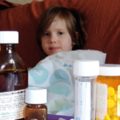Fevers, sneezes and wheezes
With the short days and long cold nights of winter come fevers, sneezes and wheezes. Parents are often concerned that a wheeze is the first sign of asthma. However the vast majority of wheezy children do not have asthma, but rather have so-called “viral induced wheeze”. This is when “colds” and viral infections can trigger the small airways in the lungs to constrict, causing the characteristic wheezing sound and subsequent difficulty in breathing. Up to one-third of children will have had a wheezy episode by age 3 years. This does not imply that this will persist throughout childhood. In fact two-thirds of children will grow out of the wheezy episodes. Factors linked with persistence include a family history of atopy i.e. asthma, eczema, hayfever or food allergies.
The triggers of asthma and viral induced wheeze are different but the acute symptoms are similar. Asthma is an inflammatory lung disease which manifests in recurrent wheeze, chronic coughing (especially at night) and difficulty in breathing. It can be difficult to diagnose in the pre-school years. Whereas in most childhood wheeze the only trigger is a virus, there can be many triggers for asthma: exercise, weather (cold air), cat & dog hair, foods, pollen, smoke, stress as well as viral respiratory infections.
Exposure to smoke (even if the smoker only does so outside the house) results in more frequent, more severe chest and ear infections and wheeze.
If your child is wheezy they might be commenced on a Salbutamol (Ventolin) inhaler. This is best used with a spacer device to ensure the medicine reaches the lungs. Infants under a year of age often do not respond to this, so alternative inhalers might be prescribed. As the cause is usually a viral infection, antibiotics are not needed. If your child does not improve despite the use of inhalers, has recurrent episodes of wheezing or features suggestive of asthma, it would be beneficial to be referred to a paediatrician.




